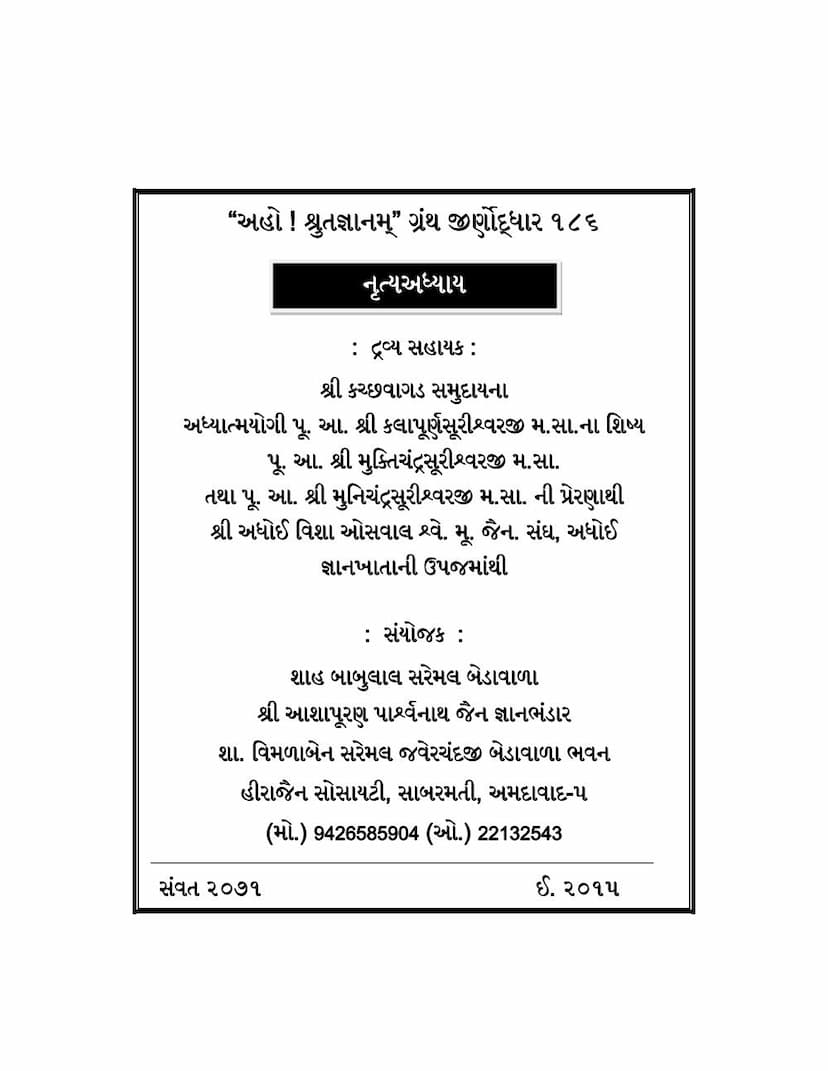Nrutyadhyaya
Added to library: September 2, 2025

Summary
Here's a comprehensive summary of the Jain text "Nrutyadhyaya" by Ashokmalla, based on the provided catalog link and page content:
Book Title: Nrutyadhyaya (A work on Indian Dancing) Author: Ashokmalla (also referred to as Ashokmalla, Ashokamallena, Nripasokamallena) Publisher: Samvartika Prakashan, Allahabad Catalog Link: https://jainqq.org/explore/034223/1
Overall Summary:
"Nrutyadhyaya" is a significant Jain text authored by Ashokmalla, who is identified as a king. The work is dedicated to the detailed exposition of Indian dancing, encompassing a vast array of movements, postures, gestures, and expressions crucial to classical Indian dance forms. The text is meticulously structured, covering every aspect of dance, from the nuances of hand gestures (hastas) and limb movements (angas and upangas) to the subtle expressions of the eyes (drishti) and facial muscles. It also delves into the significance of gaits, stances, and various stylistic movements, providing a comprehensive manual for practitioners and scholars of Indian dance.
Key Aspects and Themes:
-
Author Identification: Ashokmalla was a king, as evidenced by his self-description using terms like "Prithvindrena" (Lord of the Earth), "Bhubhujana" (King), "Nrupagrani" (Foremost of Kings), and "Veirasimh-sutah" (Son of Veirasimha). While historical details about his reign are scarce, scholars estimate his time period to be around the 14th-15th century CE, possibly residing in central-western India. He was not only a learned king but also a connoisseur of arts, particularly dance and music.
-
Textual Structure and Content: The "Nrutyadhyaya" is presented as a significant portion of a larger work on Indian dramaturgy, possibly even exceeding Bharata Muni's "Natya Shastra" in scope. The available text is divided into numerous chapters or sections (prakaranas) that systematically cover:
- Hand Gestures (Hastas): A detailed catalog of both single-handed (asamuykta) and combined-handed (samyuta) gestures, describing their forms and specific applications in dance and drama. The text enumerates 24 single-handed and 13 combined-handed gestures, with numerous variations and their uses in depicting emotions, objects, and actions.
- Lesser Limbs (Upangas): Movements of various body parts like eyes (drishti), eyebrows (bhrun), nose (nasa), mouth (mukha), lips (adhara), tongue (jihva), teeth (danta), cheeks (kapola), chin (chibuka), neck (griva), shoulders, elbows, wrists, waist, thighs, calves, knees, and ankles are explained.
- Body Movements (Angas and Pratyangas): The text details the five types of chest (vaksha), waist (kati), and thigh (uru) movements, along with the thirteen types of foot (pada) movements, and nine types of neck (griva) movements. It also describes the sixteen types of arm (bahu) movements and various leg (jangha) and knee (janu) movements.
- Stances (Sthanakas): Ashokmalla outlines 6 male stances, 8 female stances, and 23 regional (deshi) stances, along with 6 types of sleeping (supta) stances.
- Carriage/Movement (Chari): The work classifies Chari into 16 earthly (bhoumi) and 19 aerial (akashika) movements. Additionally, it lists 35 regional (deshi) earthly and 19 regional aerial movements, totaling 70 classifications of chari.
- Karanas: A very extensive section detailing 108 Karanas (choreographic units combining hand, foot, and body movements), which are fundamental to Indian dance. The text meticulously describes each Karana with its constituent elements and expressive potential.
- Angaharas: Sections dedicated to Angaharas (groupings of Karanas or movements for specific expressive purposes), categorized based on the number of constituent Karanas and the overall rhythmic patterns (talas). The text details 16 Angaharas based on the "Chaturasra" measure and another 16 based on the "Tryasra" measure.
- Rechakasa: Four primary types of Rechakasa (rotary movements of limbs) are described: namely, Pani (hand), Kantha (neck), Kati (waist), and Pada (foot) Rechaka.
- Mandals: The text outlines 10 aerial (akashika) and 10 earthly (bhoumi) Mandals (circular movements), detailing their forms and applications.
- Lasya Aṅgas: Ashokmalla describes 12 types of "Marga Sthita Lasyaṅgas" (classical dance movements) and 37 "Deshi Lasyaṅgas" (regional dance movements), further enriching the understanding of dance repertoire.
- Miscellaneous: The text also includes sections on various other aspects like the "hastapravara" (hand movements), "hastashetra" (limb positions), and "karmas" (actions of hands).
-
Scholarly Apparatus: The provided content indicates that the book was published in Gujarati and English translation. It also includes a "vishayanukram" (table of contents), "shlokanukramanika" (index of verses), and "paribhashik shabdanukramanika" (glossary of technical terms). The presence of illustrations (like "chitra-suchi" for 108 Nrittakaras) signifies a visually rich and educational presentation.
-
Preservation and Revival: The catalog entries mention "Ah Shruta Gnanam Granth Jiirnoddhar" (Revival of the 'Ah Shruta Gnanam' texts), indicating a concerted effort by organizations like Shri Ashapooran Parshvanath Jain Gyan Bhandar to scan and digitize rare and ancient Jain manuscripts, making them accessible through DVDs and online platforms (www.ahoshrut.org). This initiative plays a crucial role in preserving and disseminating Jain intellectual heritage.
Significance:
"Nrutyadhyaya" by Ashokmalla is a valuable resource for understanding the historical development and technical aspects of Indian classical dance. Its Jain origin suggests a potential philosophical or religious underpinning to the art of dance within the Jain tradition. The comprehensive nature of the text, detailing minute movements and their expressive meanings, makes it indispensable for dancers, choreographers, art historians, and researchers interested in the rich cultural and artistic traditions of India. The revival efforts highlight the importance placed on preserving such ancient knowledge.